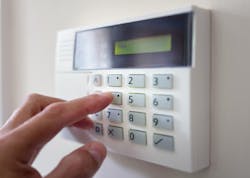Burglar, fire alarms targeted in latest round of China tariffs
Earlier this week, the Trump Administration escalated its ongoing trade war with China, announcing it would impose 10 percent tariffs on about $200 billion worth of additional goods from the country. While a number of security industry products have already been impacted by previously announced tariffs, this latest round could a have a more far-reaching effect on the industry and potentially raise prices for myriad devices, most notably burglar and fire alarms.
The broad product segment listed in the latest U.S. Trade Representative’s Office (USTR) document simply as “Electric Burglar and Fire Alarms (8531.10.00),” will undoubtedly be impactful to a wide range of companies in the security ecosystem, including not only those who install intrusion and fire alarms but also central station monitoring providers.
Understanding what typical security and life safety products will be affected is done by researching the HTS Code that the manufacturer in China specifies on their export documents. For example, a typical product under this heading and exported by one manufacturer in mainland China includes the following description, features and what is actually packaged in shipment. Keep in mind this is one example; additional systems and devices may differ.
Product Description:
Smart Home Security Alarm with GSM Connectivity and Auto Dial Feature: This security protection device is intended for residential and office applications. Based on the wireless GSM communication network, the system includes an integrated LED menu display and controller. When a sensor is triggered, the GSM alarm system will make a call or send an SMS to the subscriber’s telephone automatically.
Typical Features:
- Transmission: (433MHz, 850/900/1800/1900MHz)
- LCD screen with clock display
- 2 wired and 10 wireless intrusion zones, supports 100 wireless sensors + 2 wired sensors
- Supports a maximum of 8 remote controllers
- Voice function (arm, disarm and others)
- Multi-language support including English
- 6 auto dialer phone numbers, 3 preset SMS numbers
- Answer cell phone (arm, disarm, listen to the scene, talk), use SMS to operate, activate wired siren
- Use the keypad to make calls
- One-key-control: “Away” arm, “Stay” arm mode by remote controller or phone call
- SOS, fire, gas, door, hall, window and perimeter alarm descriptions
- Real-time, delay, 24 hours zone programming function
- Wireless learning code: easy to add additional wireless accessories
- Remote control to arm, disarm, monitor and command by phone
- Alarm Audit Trail: up to 30 alarm records
- Arming initiation in different ways: via panel keypad, remote controller or remote call
Typical Product Packing Includes the Following:
- Alarm panel x 1
- PIR motion sensor x 1
- Wireless door sensor x 1
- Power Adapter x 1
- Remote controller x 2
- User manual (online or printed)
Published Data on Burglar Alarm System Imports identified with HTSUS Code 853110
There is published data showing the increase of burglar alarm system imports by year, with the U.S. typically having flatter trends on export. Also of interest are the top states in the U.S .consuming or importing these products. Keep in mind that the product’s final destination may vary, as a high volume distribution office may be located in California or Texas, skewing the data.
Other Impacted Products:
In the last three Harmonized Tariff Schedules (HTSUS), we saw significant product and infrastructure impact in microcomputers, fiber optic cables and transmitters, and even wireless network appliances. Here is a look at some additional products, in decreasing order from high to low impact, that will be affected by this latest round of tariffs:
(Note: The official U.S. Trade Representative’s Office (USTR) document are classified in 8-digit subheadings; thus, where possible, the Harmonized Tariff Schedule (HTS) eight digit number will be listed in parentheses for reference purposes)
High Impact:
- Audio devices, components and assemblies (microphones and loudspeakers) (8517.69.00- 8522.90.36): Acoustic signature detection, gunshot detection, microphones to natural language systems and audio-visual mass notification systems have always been a core solution for A/V installers but now that they are becoming mainstream solutions for today’s systems integrator, we will most likely see a significant impact.
Medium Impact:
- Computer and Server Systems, peripherals such as optical drives and mass storage (8471.60.10- 8471.90.00): Security application software solutions need platforms to run on, and the non-cloud-based infrastructure is now tariffed.
- Television Cameras, Digital Cameras and Video Camera Recorders (8525.80.30-8525.80.50): A growing segment of the surveillance market and an established portion of the audio/visual market leverages network cameras having 1080p/4K/8K resolution used for broadcasting televised events. These cameras are often also used for long range traffic reporting applications, such as a full view of a bridge crossing with the option to “zoom in” on a traffic incident. This video stream is typically broadcasted to multiple television and cable affiliates. “Television Cameras” and “Video Camera Recorders” are now tariffed.
- Objective lenses for Cameras (general category) and Closed Circuit Television Cameras (9002.11.60- 9002.90.85): Itemized in previous Tariff Schedules, lenses for CCTV and Network Video Cameras continue to be tariffed.
Low Impact:
- Automatic Teller Machines (8472.90.10): There are several Chinese manufacturers of ATMs and the included security devices by OEMs that will affect some retail financial institutions.
- Cards incorporating a Magnetic Stripe (8523.21.00): Magnetic stripe cards are still used for electronic access control systems in some verticals like aviation and retail; this restriction may be the push end-users need to simply move to proximity readers and cards. The majority of cards with a magnetic stripe include EMV chip technology, rapidly becoming the global standard for credit card and debit card payments. Many do not realize they were named after the technology founders Europay, MasterCard and Visa. These payment and access control instruments have embedded microprocessor chips that store and protect cardholder data. It is not known if this tariff is applied to all cards with a magnetic stripe or cards with only a mag stripe.
About the Author:
Steve Surfaro is Chairman of the Public Safety Working Group for the Security Industry Association (SIA) and has more than 30 years of security industry experience. He is a subject matter expert in smart cities and buildings, cybersecurity, forensic video, data science, command center design and first responder technologies. Follow him on Twitter, @stevesurf.
About the Author

Steve Surfaro
Steve Surfaro
Steve Surfaro is Chairman of the Public Safety Working Group for the Security Industry Association (SIA) and has more than 30 years of security industry experience. He is a subject matter expert in smart cities and buildings, cybersecurity, forensic video, data science, command center design and first responder technologies. Follow him on Twitter, @stevesurf.
